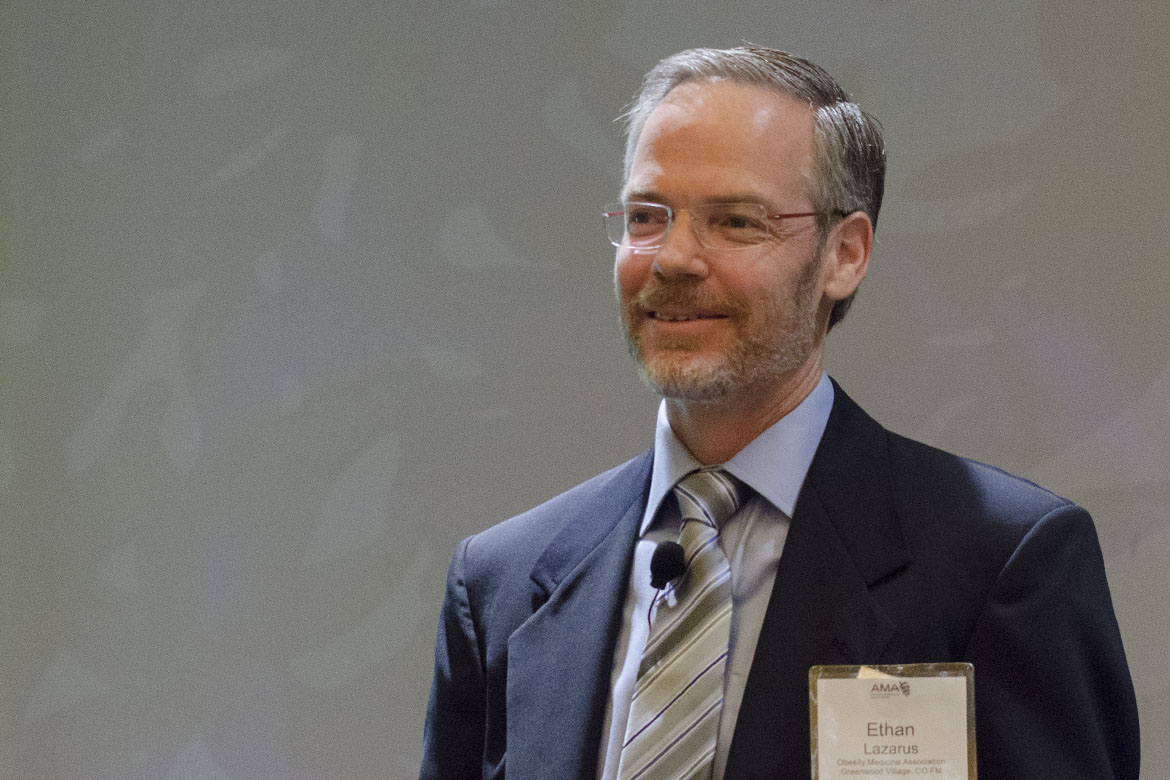The numbers, so commonly cited, remain staggering. Obesity affects more than one in three American adults, according to the Centers for Disease Control and Prevention. It is also often associated with 236 comorbidities, such as diabetes, high blood pressure, heart disease and 13 different cancers. Yet physicians and other health professionals are too often hesitant to have open discussions about obesity with patients.
This uncharacteristic physician reticence was explored in a recent education session by Ethan Lazarus, MD, who reviewed current concepts in obesity medicine. Dr. Lazarus, the son of 2012–2013 AMA President Jeremy Lazarus, MD, is the secretary/treasurer of the Obesity Medicine Association (OMA). Practicing in suburban Denver, he specializes in helping individuals lose weight and live happier, healthier lives.
To overcome the stigma associated with obesity, Dr. Lazarus recommended opening the conversation and using person-first language (e.g. refer to a “patient with obesity,” instead of an “obese patient”). This can be performed if physicians begin to look at obesity like diabetes—there’s pre-obesity and obesity. It isn’t two separate diseases, but similar to diabetes, it allows physicians to provide measures to prevent obesity. By choosing the right approach, physicians can begin to address obesity with their patients without feeling uncomfortable.
Nearly half of people with obesity don’t even know they have it because health professionals are uncomfortable talking about it, Dr. Lazarus said during the education session at the 2017 AMA Annual Meeting. This is what is going on with obesity—half of the people with obesity don’t know if they have it or not. Of those that are diagnosed, 75 percent don’t receive a follow-up visit. They are diagnosed, know they have obesity, but they don’t receive any evidence-based treatment.
“The problem lies in the discussion,” said Dr. Lazarus. “Physicians are not comfortable speaking about obesity. It’s a different style of care than we would do with other diseases because there’s so much bias and stigma with weight.”
If physicians can overcome the idea that obesity is a fault-based disease, treatment can improve, he added
Obesity’s massive economic toll
A study by the Milken Institute found that direct medical cost of obesity is $427.8 billion, while total expense—including money spent on treating obesity-related conditions and lost work productivity—was $1.42 trillion. Treatment consumes 14.3 percent of health care spending and 320,000 deaths can be attributed to obesity annually. If physicians can help their patients drop 5 percent in weight, there can be over $2,137 cost savings per person.
“It’s hard to even imagine the magnitude of this problem, isn’t it? It’s such a huge problem,” said Dr. Lazarus. “This is nothing new. We know we should be screening patients for obesity.”
Many times physicians will see their patients and tell them to lose weight. But Dr. Lazarus suggested physicians go beyond instructing patients to lose weight—which he likened to instructing the patient to lower their blood pressure. Weight loss is more of an outcome than a treatment.
“Is anyone comfortable talking about diabetes?” asked Dr. Lazarus. “That’s an easy one to talk about. We recognize prediabetes and the goal is to not get diabetes. If the patient has diabetes we are going to monitor the patient.”
As with prediabetes, the goal in pre-obesity should be to prevent obesity. Providing education on eating and exercise; sleep; medication; and surgery—when needed—are all treatment options. It all starts with a conversation with the patient in the exam room, but it is important to use patient-sensitive language.
When it comes to drug therapies, it is important to understand when to stop and when to continue use. Dr. Lazarus recommended stopping a weight-loss drug treatment if it isn’t providing 5 percent weight loss after three months as that is not enough of a benefit to justify continued use.
Read more news coverage of the 2017 AMA Annual Meeting.
- What it's like to be in obesity medicine: Shadowing Dr. Lazarus
- 3 ways to mitigate implicit bias in the exam room
- Video: How one doctor is looking at obesity in a novel way
- Obesity rates fall in 4 states, but overall rates remain high




